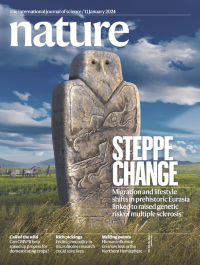Volume 625
-
No. 7996 25 January 2024
Brain drainCerebrospinal fluid (CSF) circulates around the brain and the spinal column, providing mechanical support and nourishment, and helping to clear away impurities. Although it has long been known that CSF drains through the lymphatic system, the precise connections and regulation for the process have proved elusive. In this week’s issue, Gou Young Koh and colleagues use fluorescent tracers in mice to reveal a network of lymphatic vessels at the back of the nose, called the nasopharyngeal lymphatic plexus, which facilitates CSF flow from the brain to lymph nodes in the neck — shown on the cover, where green highlights the direct connection of the plexus (upper region) to deep-neck lymphatics (middle and lower regions), blue indicates blood vessels and red is smooth muscles. The researchers note that the plexus is regressed and loses functionality with age, which could inhibit clearance of disease-linked proteins such as amyloid-β, but they show that it is possible to pharmacologically stimulate deep neck lymphatics to counteract the age-related drop in the hub’s functionality.
-
No. 7995 18 January 2024
The great ex-apeStanding some 3 metres tall and weighing 200–300 kilograms, Gigantopithecus blacki is thought to be the largest primate that ever lived. Pictured in an artist’s reconstruction on the cover, the giant ape was found in China between 2 million and 300,000 years ago, but why it died out remains a mystery. In this week’s issue, Yingqi Zhang, Kira Westaway and colleagues shed light on the timeline and cause of this primate’s demise. The researchers collected and dated fossils from 22 caves in southern China, which they then matched with pollen analysis. They found that 2.3 million years ago, the environment consisted of dense, closed-canopy forests and grasses, ideal for G. blacki, but between 295,000 and 215,000 years ago, this shifted to more open forests with a change in the forest plant communities. This led to a less diverse diet for the giant ape, and the fossils show signs of increased stress and dwindling numbers for this period. Ultimately, the researchers suggest, G. blacki was unable to adapt to its changing environment.
-
No. 7994 11 January 2024
Steppe by stepAcross four papers in this week’s issue, Eske Willerslev and colleagues use genetic data from ancient Eurasians to probe the effects of cross-continental migrations on prehistoric populations. The researchers unpick some of the genetic changes that have probably resulted from the mixing of ancient steppe, farming and hunter-gatherer populations. In particular, they identify that steppe migrations brought an elevated genetic risk for multiple sclerosis to Europe, probably as the result of evolutionary pressures associated with protection from pathogens as the population switched from hunting and gathering to farming and raising livestock. The cover image uses an illustration of a typical Kurgan stele, found in ancient cemeteries in the Eurasian steppe, to host imagery relating to the genetic links with risk of multiple sclerosis.
-
No. 7993 4 January 2024
Growth factorThe cover shows an artist’s impression of a massive young star in the process of forming. Around it is a disk-like structure of gas and dust from which the star accretes matter for its further growth. Associated with the accretion process, the star is also launching a powerful bipolar jet. All of the direct detections of disks around massive young stars are in the Milky Way, but in this week’s issue, Anna McLeod and colleagues present the discovery of an accretion disk around a massive young star in our nearest neighbouring galaxy, the Large Magellanic Cloud. The researchers’ observations suggest that there is a rotating toroid feeding the accretion disk and thus the growth of the star. Unlike other such young stars, this star can be detected optically, a consequence of the fact that it is developing in a region with low dust content and low metallicity.




